I’ve embarked on a new adventure and frankly, it is taking over my life. I went to one seminar, Monarch Tagging and Releasing with Drake White (The Nectar Bar), and took one trip to visit Laura Jarvis’s (our event coordinator) backyard butterfly oasis back in October and I was hooked. I wanted to have caterpillars crawling all over my hands! I wanted to see the magical transformation from caterpillar to chrysalis to butterfly happen right before my very own eyes! I wanted a newly eclosed butterfly to perch upon my finger; and I wanted a swirling swarm of butterflies to greet me in my yard on sunshiny days too!
(I mean, who wouldn’t want to do this? Get them on my fingers!)
Towards the tail end of fall, my wish fell into my lap. Well, more like fell onto my anisacanthus (hummingbird bush). I looked out the window one day and noticed that the tips of the plant appeared to be dying. Leaves stripped from top to bottom in just one select area. I ran outside to shake my fists at whatever offending pest was creating the damage but pulled up short when I saw a gang of itty bitty caterpillars impressively munching their way down the stem. Me, being a newbie, snapped a picture with my phone and sent it to Laura and Drake asking, “Are these the good guys or bad guys?” When they confirmed with enthusiasm that they were not only “the good guys” but also that they were more specifically Crimson Patch caterpillars, I knew I had just been given a gift.
(The “good guys.” Crimson Patch caterpillars. The obsession begins.)
This gift quickly turned into an obsession. I checked my plant everyday to watch for any change. And change did come, but not in the form I was expecting. One morning I went out to find tiny, fuzzy-like balls on the stem where my caterpillars had been. A cold spell had recently come through and I thought my beloved caterpillars had frozen to death! After numerous panicked calls and texts to Laura, she calmed me down enough to go out and check other leaves for the possibility that the caterpillars had just went through an instar, basically molting when they become too large for their skin. They digest and absorb most of their outer covering to develop into their next stage. Lo and behold, that’s exactly what they did! Larger caterpillars were happily munching away on some lower leaves. Apparently they go through many instars, five actually, before being ready to go into a chrysalis. They would go from being beautiful caterpillars with mint-green bodies and black, spiky stripes to shriveled brown/black blobs each time. Did learning this fact stop me from panicking each time they did it? No, not at all! I drove my husband crazy each time I announced that I had killed my caterpillars and then followed up with, “Oops, just kidding, they are fine!” He kept telling me, “I think the caterpillars know better than you how they are suppose to survive!” I didn’t think so, so I decided to move my caterpillars inside to protect them from the freezing days to come. I could have left them outside where they might have overwintered, but I was worried that they’d venture off into dry leaves and be raked up by accident.
(Right after they went through an instar. See why I was so freaked out? Shriveled little fuzzy blobs!)
I moved the entire potted plant into the garage and made a makeshift cover out of some mesh material and some handy dandy vice clips to keep them from crawling into unknown spots of my garage whenever they became ready to make a chrysalis. Turns out I probably didn’t need to worry about that for awhile. They decided, about two seconds after I moved them, to go into diapause. For us laymen, this is kind of like hibernation, or going into a state of dormancy. They can do this at many different stages of their lives. Did knowing this fact stop me from freaking out with thoughts that they were dead? No, not at all! I continued to annoy my husband on a daily basis with concerns that I had become a murderess! I’ve never experienced the complete life cycle of a butterfly before, so having my caterpillars shrink up and go into diapause just before going through another instar was very disconcerting! Combine this with the fact that I also had a hard time finding info on the life cycle of this specific caterpillar/butterfly, and maybe you will understand why I had a lot of hand-wringing anxiety. I sure picked a doozy of a butterfly to start my new passion.
(Here is my makeshift enclosure. And here is where they tortured me for months in diapause.)
Fast forward (thank goodness, right?) through 3 months of a crazed woman checking on her caterpillars more often than making meals for her family and we arrive at the end of February, after a stretch of unseasonably warm weather. I do my torturous, daily ritual of checking on my shriveled up “cats” and find a few mint-green and black spiky fellas crawling around outside the confines of my netting. “Joy! Happiness! They are awake and alive!” I scream. “Joy. Happiness.” replies my husband in a monotone voice, exhausted from his captivity in my day to day caterpillar observations. I prance out to the garage and move them into my new butterfly enclosure (a Christmas present from my husband to shut me up, he loves me, he really does.). I add some cuttings of the anisacanthus to jars with their tops secured by saran wrap (don’t want the little buggers falling in). Before I know it, I have about 14 caterpillars moving around, munching, and getting fat and happy. They really do know what they are doing! In a matter of a week, a few have found their way to the sides of the enclosure and positioned themselves in the shape of a “J”, the telltale sign of Crimson Patch caterpillars getting ready to form a chrysalis.
(Guess who is awake?)
(New home! No getting out!)
(The one on the right is starting to make a “J” with his body. Maybe he’s teaching the one on the left.)
This brings us to today (thank goodness, right?). I currently have 3 chrysalises formed in the enclosure and am eagerly awaiting the emergence of some beautiful Crimson Patch butterflies. A few “cats” are at different stages and still going through instars, but I’ve chilled out about it now that I’ve seen the results. Each day I see another fatty searching for a perfect spot to hang in his chrysalis. I’m still very much obsessed with these amazing creatures. If someone shows me a picture of their newborn, I find myself pulling out my phone to show them MY “baby” swaddled up in its burrito-like chrysalis. My daughter has jumped on board the insanity train and is naming all the caterpillars androgynous names since we haven’t figured out yet how to tell if they are male or female. We’ve got a Logan, Riley, Preston, and Taylor so far. If you think of any good ones, send them our way and we’ll add pictures when the butterflies come to show the ones you’ve named. I’ve been pretty busy growing my own host and nectar plants in anticipation of the upcoming butterfly season. I’m hoping to raise some Monarchs and Queens next. Think I can do it? Hey, I think I just saw my husband roll his eyes!
(More chrysalises to come! I’m so excited!)
(Preparation for butterfly season!)
~The Happy Gardener
~Lisa Mulroy

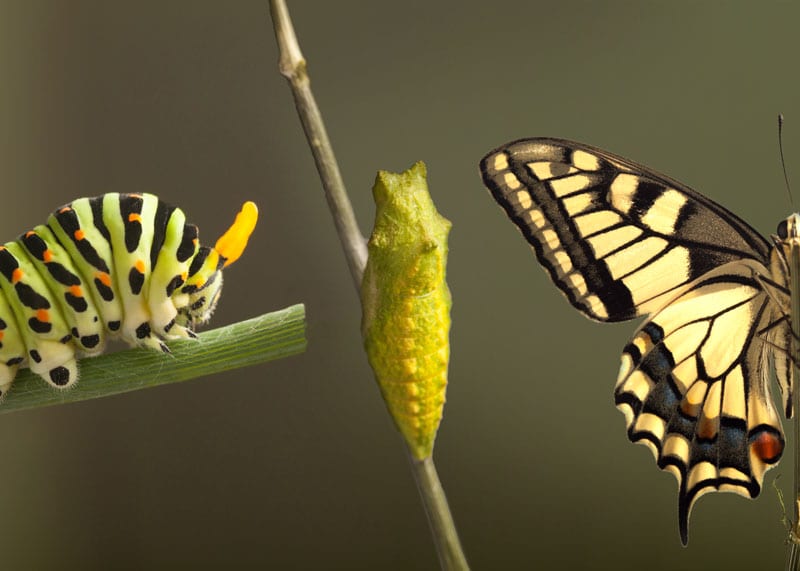
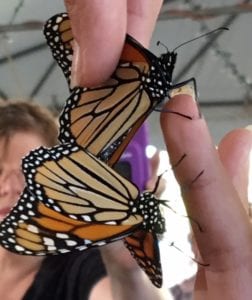
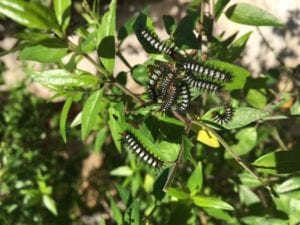
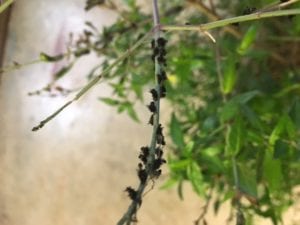
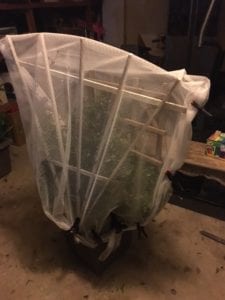
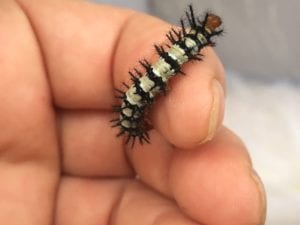
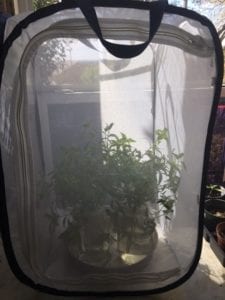
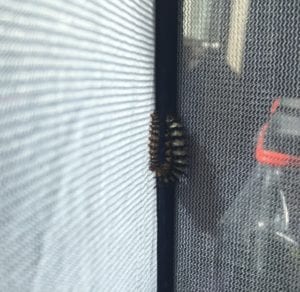
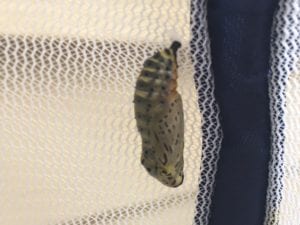

Found fuzzy caterpillar , he’s doing fine I have been seeing white things next to him, what’re these? He’s in a container nothing else can get in????
Hi there,
Can you send some pictures of the caterpillar and the white things you see as well? Would need to see to identify.
Hey, I just found a caterpillar among my veggies I was aboit to boil, I saved him, put him I’m the box outside with the veggies and it was super sunny. Now it bármely moves and doesn’t wanna eat.more leaves. What shall I do??
Do you have any idea what type of caterpillar it is? If it was among your veggies, it could be a hornworm or cutworm. Or if a butterfly caterpillar, I guess it could have gotten damaged in the transport before you realized it was there. Maybe he’s just full. Need some more info to know if it is a butterfly caterpillar or not.